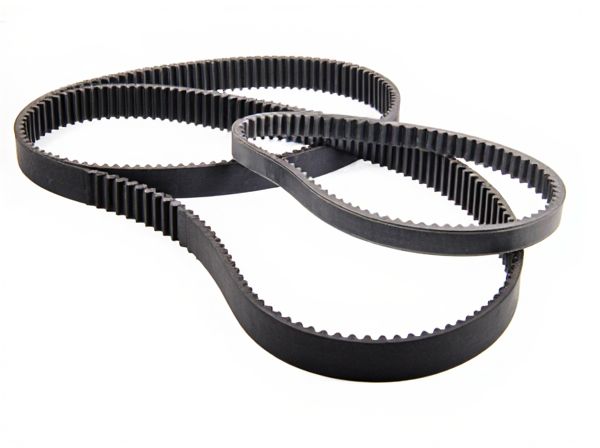
Photo illustration: High-Temperature Timing Belt vs Standard Timing Belt
High-temperature timing belts are specifically designed to withstand extreme heat conditions, ensuring durability and reliable performance in engines exposed to high temperatures. Standard timing belts, while effective in general applications, may degrade faster under heat stress, potentially leading to premature failure. Choosing the right timing belt for your vehicle's operating environment can significantly impact engine efficiency and longevity.
Table of Comparison
| Feature | High-Temperature Timing Belt | Standard Timing Belt |
|---|---|---|
| Material | Heat-resistant polymers and reinforced fibers | Standard rubber and fiber composite |
| Operating Temperature | Up to 150degC (302degF) | Up to 100degC (212degF) |
| Durability | Enhanced resistance to thermal degradation | Prone to wear under high heat |
| Application | High-performance and heavy-duty engines | Standard passenger vehicles |
| Cost | Higher upfront investment | More affordable, standard pricing |
| Maintenance Interval | Up to 100,000 miles (160,934 km) | Typically 60,000-90,000 miles (96,561-144,840 km) |
| Performance | Consistent timing accuracy under extreme heat | May lose tension and accuracy at high temperatures |
Introduction to Timing Belts
Timing belts are essential components in internal combustion engines, coordinating the rotation of the crankshaft and camshaft to ensure precise valve timing. High-temperature timing belts are engineered with heat-resistant materials such as EPDM rubber and aramid fibers to withstand extreme operating conditions, preventing premature wear and failure. Standard timing belts, typically made from neoprene with fiberglass reinforcement, perform well under normal thermal conditions but may degrade faster in high-heat environments.
What is a High-Temperature Timing Belt?
A high-temperature timing belt is engineered with heat-resistant materials such as silicone or fluorocarbon rubber to withstand extreme engine temperatures exceeding 150degC, making it ideal for high-performance or industrial applications. Unlike standard timing belts made from neoprene or rubber, these belts maintain flexibility and durability under thermal stress, preventing premature wear and ensuring precise engine timing. High-temperature timing belts contribute to improved engine reliability and longevity in demanding environments where conventional belts would degrade rapidly.
Standard Timing Belt: Features and Applications
Standard timing belts are typically made from rubber reinforced with fiberglass or Kevlar for strength, designed to operate efficiently within temperatures ranging from -30degC to 100degC. Their key features include flexibility, durability, and resistance to abrasion, making them ideal for conventional automotive engines, small machinery, and light industrial applications. These belts ensure precise synchronization of engine components or mechanical parts, delivering reliable performance in environments without extreme heat exposure.
Material Composition: High-Temperature vs Standard Belts
High-temperature timing belts are composed of specialized materials such as heat-resistant polyurethane or silicone combined with aramid or fiberglass cords, enabling them to withstand extreme operating temperatures exceeding 150degC. Standard timing belts typically utilize neoprene or rubber with fiberglass or nylon cords, designed for moderate temperature ranges up to 100degC. The enhanced material composition of high-temperature belts ensures superior durability, reduced wear, and reliable performance in demanding industrial or automotive applications.
Performance Under Extreme Conditions
High-temperature timing belts are engineered with advanced materials like heat-resistant polymers and reinforced fibers, enabling them to maintain integrity and performance in extreme heat environments exceeding 200degC. Standard timing belts, typically made from rubber and fiberglass, degrade faster under high thermal stress, leading to loss of tension, cracking, and eventual failure. The superior thermal stability and durability of high-temperature timing belts make them essential for applications in heavy-duty engines, industrial machinery, and aerospace systems operating under intense thermal conditions.
Heat Resistance Capabilities
High-temperature timing belts feature advanced materials such as heat-resistant rubber compounds and reinforced fibers, enabling them to withstand operating temperatures up to 250degC, compared to standard timing belts which typically degrade beyond 100-120degC. These belts maintain tensile strength, flexibility, and dimensional stability under prolonged thermal stress, making them ideal for industrial machinery and automotive engines operating in harsh thermal environments. The enhanced heat resistance capabilities significantly extend belt life and reduce maintenance costs in applications with elevated temperature demands.
Lifespan and Durability Comparison
High-temperature timing belts are engineered with advanced materials that resist heat degradation, resulting in a lifespan up to 50% longer than standard timing belts under extreme thermal conditions. Standard timing belts, typically made from rubber compounds, degrade faster when exposed to high temperatures, reducing overall durability and increasing the frequency of replacement intervals. The enhanced heat resistance of high-temperature belts ensures consistent performance and lowers maintenance costs in engines subjected to elevated operating temperatures.
Cost Analysis: High-Temperature vs Standard
High-temperature timing belts typically cost 20-40% more than standard timing belts due to their specialized heat-resistant materials and enhanced durability. While the initial investment is higher, high-temperature belts reduce maintenance frequency and downtime in extreme conditions, potentially saving costs over the belt's lifecycle. Standard timing belts offer a lower upfront price but may incur higher replacement and operational costs in high-heat environments.
Ideal Applications for Each Type
High-temperature timing belts excel in automotive engines and industrial machinery exposed to extreme heat, offering enhanced durability and resistance to thermal degradation. Standard timing belts are ideal for everyday vehicles and light machinery where operating temperatures remain within typical ranges, ensuring cost-effectiveness and reliable performance. Selecting the appropriate belt type depends on the application's temperature demands and environmental conditions to maintain optimal timing accuracy and longevity.
Choosing the Right Timing Belt for Your Needs
High-temperature timing belts are engineered with heat-resistant materials like fiberglass and advanced polymers, making them ideal for engines exposed to extreme thermal conditions or heavy-duty applications. Standard timing belts, typically made from neoprene or EPDM rubber, perform well in everyday driving scenarios with moderate temperature ranges and lower mechanical stress. Selecting the right timing belt depends on assessing your vehicle's operating environment, engine specifications, and load demands to ensure optimal durability and performance.
 caratoz.com
caratoz.com